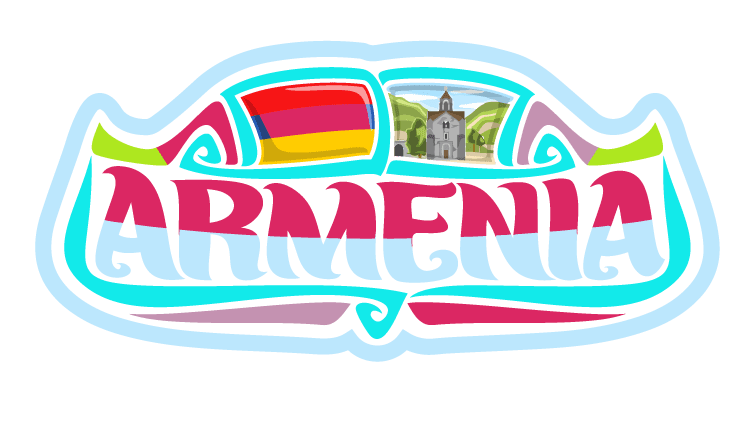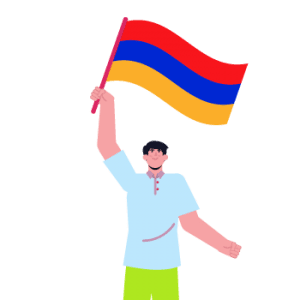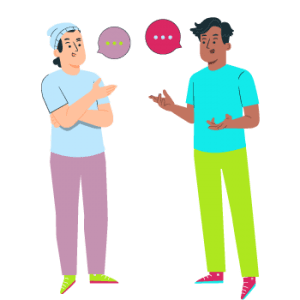
What Language Do They Speak In Armenia?
Republic of Armenia
Armenia, officially the Republic of Armenia, is located in Western Asia, in the South Caucasus region, with Turkey to the west, Georgia to the north, Iran to the south, and Azerbaijan to the east. The capital and largest city of Armenia is Yerevan. The terrain of Armenia is primarily mountainous, with a small portion of its territory (11%) lying at the center of the Ararat plain in west-central Armenia.
Yerevan, which has over 1 million inhabitants (2013 estimate), was founded in 782 BC by king Argishti I at the center of the Armenian Highland. Yerevan, the capital of Armenia, has an ethnically diverse population, with Russian, German, and Azeri communities making up a significant portion of the people. But what modern languages are spoken in Armenian? What is the official language? Let’s find out!
The Language of Armenians
The official language of Armenia is Armenian, which is spoken by most of the population. However, there are also minority languages spoken in Armenia, such as Eastern Armenian and Western Armenian. The Armenian population is largely monolingual, with over 96% of people speaking Armenian as their first language.
However, a significant minority of Armenians also speak Russian, Turkish, or other foreign languages. Western Armenian speakers are primarily located in Istanbul, but they have historically been scattered throughout Western Europe and the Americas.
Eastern Armenian speakers comprise around 3% of the population and live primarily in Yerevan, Nagorno-Karabakh, and Iran. Meanwhile, Western Armenian speakers include approximately 1% of the people and live primarily in Turkey and Greece.
Although they were once Armenian’s dominant group, Eastern Armenian speakers now only account for about 10% of all native Armenian speakers. Today, these two dialects differ in terms of phonology (Eastern uses pharyngeal consonants), morphology (Eastern has more inflections), vocabulary (Western uses more words borrowed from European languages), syntax (Eastern is SOV while Western is SVO), and orthography (Eastern employs accents).

Origins of the Language
The Armenian language is an Indo-European language that was first spoken by the Armenian people. It is the official language of Armenia and is also spoken by the Armenian diaspora. In the early 20th century, only about 3 to 4% of the Armenian population could speak this language. The Armenian alphabet was invented in 405 AD by Mesrop Mashtots. The Armenian population is estimated to be around 10 million people. There are two modern dialects of Western Armenian, which are based on geography. Eastern Armenian is based on old vernaculars from Van, Lake Sevan, and Artashat. Western Armenian has been influenced by eastern and western dialects and Arabic and Persian loanwords.
There are many Arabic words in Western Armenian such as kohl for black powder used to darken eyelashes or nouak for clove, or cinnamon stick used for cooking. Still, there are also common words such as spitoon (meaning toilet) or tsakhkadzor (meaning bathing). Western Armenian is mainly spoken in Turkey, which is recognized as a minority language, although it isn’t taught in schools. Eastern Armenian is spoken primarily in the Republic of Armenia and Iran. Eastern Armenian uses more classical vocabulary with less influence from Turkish or Arabic than Western Armenian does.
Eastern Armenian has fewer loanwords and shares more similarities with Classical Armenian than Western Armenian. Southeastern Armenian has very few speakers and no standard written form; however, its most common modern dialect can be found among some groups living near the borders of Azerbaijan and Georgia who speak it along with Azerbaijani or Georgian.
A much rarer dialect called Northeastern Armenian is also spoken in northeastern regions bordering Russia. The southeastern, northeastern, and northwestern languages have diverged enough over time to be considered different modern languages rather than dialects of one language. These three together are often referred to as Cilician Armenian, and they use the distinct Syriac script.
Why There Are So Many Different Armenian Dialects?
There are many Armenian dialects because the country has been divided and conquered many times. The most common dialects are Western Armenian, Eastern Armenian, and Karabakh Armenian. But each of these dialects varies slightly in spelling and pronunciation. So while they are all considered Armenian, they do not all sound the same. Another thing to note is that Turkish was one of the first languages spoken by Armenians, but it is now rarely used today. Modern Armenian is based on Western Armenian but with a lot of Russian words thrown in from the time when the Soviet Union occupied Armenia. Russia still dominates much of business life there.

Minority Languages in Armenia
Armenia is home to several minority languages, including Russian, Yezidi, Assyrian, and Kurdish. While most Armenians speak Armenian as their first language, many are bilingual or multilingual. Russian is the most common second foreign language, followed by English.
There are also smaller numbers of speakers of other languages, such as French, German, and Spanish. Some Armenians have learned a few words in these languages to help them visit these countries. Other people may have learned these languages at school because they have ethnic ties with the country where that language is spoken.
For example, some Armenians living in Russia learn Russian at school. If someone’s grandparents came from France, they might know some French words from when they were younger.
The list of minority languages is not complete. Languages like Greek and Persian are spoken by a small number of people. However, it’s important to note that not all minorities have been recognized as official minority languages! Only Russian, Yezidi, Assyrian, and Kurdish are official minority languages in Armenia.
The Armenian Language Today
The Armenian language is an Indo-European language spoken by the Armenian people. It is the official language of Armenia and has two main dialects: Eastern Armenian and Western Armenian. There are also two minority languages spoken in Armenia: Assyrian and Azerbaijani. Although it was once believed to be a dialect of Georgian, Western Armenian was found to be its separate language after both linguistic studies and population censuses. The Turkish invasion during World War I drove many Armenians out of their homeland, creating a sizable Armenian diaspora community primarily located in Russia, France, the United States, Syria, Lebanon, Iran, and Argentina.
As such, these days, it’s difficult to say which country speaks what Armenian as many have adopted other languages from their new homes. For example, in Iran, some Armenians speak Persian at home while others still speak Armenian. On the other hand, those who live in Syria speak Arabic with only a few words of Armenian left over from childhood or marriage. Those living in America generally learn English before learning any form of Armenian.
However, not all diaspora members have lost touch with their ancestral tongue. Some teach it to their children and even use it as one language of instruction at schools where they’re taught alongside either French or Russian. The more recent history between Armenia and Turkey has created less understanding among them due to lingering hostility stemming from various international conflicts like the Cold War and Nagorno-Karabakh War. Consequently, there are fewer speakers of Western Armenian in Turkey than there used to be.
One estimate places the fluent speakers at around 5% (although this could include individuals with passive knowledge). Many other Turks don’t even know that there’s another language besides Turkish since they’ve never been exposed to it. The New York Times cites a 2011 study on the issue conducted by linguist Yaron Matras about Turkish perceptions of non-Turkish languages in general. Of the respondents interviewed, he said that most were unaware that Armenian existed. What does this tell us about how languages operate on different levels?
While we can find some examples of communities within the Armenian diaspora who have managed to maintain fluency in their native tongue, often, when a group moves to a new place without much contact with their past culture, they assimilate into their new surroundings. Languages change through migration and interaction with other cultures, as do the people who speak them. This process of becoming can be seen in Armenian as a result of the diaspora, but also in English and other widely spoken languages.
Even though the Armenian language has survived and changed with time, it remains endangered. A combination of pressures—both historical and modern—have put pressure on the continuity of the Armenian language, but movements to preserve it continue. Today, ethnic Armenians makeup 97% of the population in Armenia and thus share a common language. According to the CIA Factbook, 3% of the population comprises Yazidis, Russians, Kurds, Ukrainians, and Georgians.
What language is Armenian similar to?
Armenian is a unique language spoken by around 6 million people worldwide. It is part of the Indo-European language family and is therefore related to languages such as English, German, and Russian. However, it is also influenced by nearby languages such as Turkish and Persian. As a result, Armenian has a unique sound and structure, making it a fascinating language to learn.
What languages influenced Armenian?
Armenian is an Indo-European language that is believed to have been influenced by many other standard languages over the years. Some of the most notable influences include Greek, Persian, and Arabic. While the exact history of Armenia is somewhat unclear, it is believed to have first emerged in the 6th century AD.
Foreign Languages Spoken In Armenia
Armenia is a landlocked country located in the southern Caucasus region. The official language of Armenia is Armenian. However, many Armenians also speak Russian, English, and other languages. In this essay, we will discuss the most common foreign languages spoken in Armenia, as well as the reasons why they are spoken.
Russian
The most common foreign language spoken in Armenia is Russian. This is due to several historical, political, and cultural factors. First, Armenia was part of the Soviet Union for many years, during which time Russian was the official language.
Even after Armenia gained independence, Russian remained the dominant language in education and the media. Additionally, Armenia has close ties to Russia, both politically and culturally. As a result, many Armenians learn Russian to communicate with family and friends, as well as to access Russian media and literature.
One of the main reasons that Russian is the most common foreign language spoken in Armenia is the country’s history. For many years, Armenia was part of the Soviet Union, during which time Russian was the official language. Even after Armenia gained independence, Russian remained the dominant language in education and the media. As a result, many Armenians are fluent in Russian.
Another reason Russian is the most common foreign language spoken in Armenia is the close ties between the two countries. Armenia has close political and economic ties to Russia, and many Armenians have family and friends in Russia. As a result, Armenians need to be able to communicate in Russian.
Another reason that Russian is the most common foreign language spoken in Armenia is because of the country’s culture. Armenia has a rich culture and history, and many Armenians are interested in Russian literature and media. Additionally, Russian is the language of the Armenian Orthodox Church, which is an essential part of Armenian culture.

English
Another common foreign language spoken in Armenia is English. English has become a common second language, especially with the influx of foreign-owned businesses and joint ventures and the popularity of the Armenian diaspora in the US. In Armenia, English is a mandatory subject from the third grade through secondary education and is taught by native English speakers.
On a pan-European scale, Armenians have also been influential in the modern Western world. For example, many prominent mathematicians of the 19th and 20th centuries were of Armenian descent, including Darboux, Hadamard, and Bolyai. French composer Maurice Ravel is considered one of the most excellent musicians of the 20th century.
Other Languages
Armenia is bordered by three countries: Turkey, Azerbaijan, and Iran. The country has a population of about 3 million, with a majority speaking Armenian as their native language. However, there are also many Armenians who speak other languages, such as French, German, and Spanish. In this article, we’ll cover the various languages spoken by Armenians and how they’re used in the country of Armenia itself.
The Armenian Alphabet and Language Facts
The Armenian language has both formal and informal versions. The standard version is used in literature and academia, whereas the colloquial language is spoken by everyday people. Armenian became an official language in Armenia in 1990. Currently, it’s one of six languages designated as a state language by law. Schools in Armenia offer Armenian as a standard language of instruction from kindergarten to 12th grade, with exceptions being made for private schools that may use a different primary teaching language.
Armenians are highly literate. According to the World Bank’s 2017 Data, 98% of adults over 25 can read and write, while 93% have completed secondary education or higher. For many speakers of Armenian, there are two ways to write the alphabet: Eastern and Western. The eastern script is called Armenian (classical) and was developed during the 5th century AD at Saint Mesrop Mashtots’ school, which was located in what is now Turkey. The western script was developed during the 10th century AD and originated in Cilicia, now part of southern Turkey. Do you know the list of weird languages?
There are 24 letters in the Armenian alphabet, but they also use Latin script, Arabic numerals, and other symbols from Cyrillic scripts, such as Greek characters. The Armenian Alphabet is written using the eastern style of writing. It uses 29 symbols and 33 letter combinations when writing Eastern Armenian. These 30-33 letter combinations vary slightly depending on their place within a word. Consonants are pronounced exactly as they are spelled; vowels are pronounced based on their position within the word.

Minority Languages of Armenia
Armenia has several minority languages; Kurmanji (the Kurdish dialect spoken by Yezidis and Kurds), Russian, Assyrian Neo-Aramaic, Ukrainian, Greek, Lomavren, and Udi.
Yazidi
As per the 2011 census, Yezidi Kurdish is spoken as the first language by 33,509 citizens of Armenia. Among them, 32,688 identified as ethnic Kurds, while the rest were non-Kurds, including 777 ethnic Armenians.
Russian
Russian is not only spoken as a foreign second language in Armenia but also serves as the mother tongue of the minority Russian and Greek communities residing in the country. As of 2011, 10,472 ethnic Russians in Armenia speak Russian as their first language. Thirteen thousand twelve non-Russians in Armenia also speak the language as a first language, of which 11,859 people are ethnic Armenians.
Ukrainian
As of 2011, 733 people in Armenia speak Ukrainian as their first language. This includes 606 ethnic Ukrainians and 127 non-Ukrainians (including 106 ethnic Armenians).
Greek
Greek is also one of the minority languages spoken in Armenia. There are very few speakers of Greek in Armenia. Also, many of the members of the small Greek community in the country speak Russian as their first language. However, a small percentage of the older generation are known to speak Pontic Greek.
Assyrian
According to the 2011 census reports, Assyrian Neo-Aramaic is spoken by 2,402 people as a first language, including 2,265 ethnic Assyrians and 125 ethnic Armenians.
Western Armenian Language
Western Armenian language is spoken by all the Armenians who had to go away and migrate to different regions worldwide. There are various countries where the Armenian diaspora is present today. The largest town of Armenians is in the US, also called “small Armenia.”
There are other regions where the Armenians reside, like France, Syria, Iran, Lebanon, etc. The Western Armenian language has certain foundations which can be found in the Western dialects.
Armenia has undergone a series of cases in which Armenian was referred to as western Armenian based on their location. All the regions/ things present on the west side of the Armenia Republic were easily classified as Western Armenian.
This word is also used for all the foreign entrances from outside Armenia. For instance, the Armenians from the Ottoman empire are known to speak Western Armenian, and all the people who migrated from elsewhere to Armenia.
Most Modern Western Armenian Language Speakers
Most modern western Armenian language speakers are currently in Lebanon, the United States of America, Georgia, Armenia, France, Syria, Turkey, Iraq, Uzbekistan, and Ukraine. This sequence of the countries is from the most speakers to the most diminutive speakers.
Western Armenian language is spoken by all the Armenians who had to go away and migrate to different regions worldwide. There are various countries where the Armenian diaspora is present today. The largest town of Armenians is in the US, also called “small Armenia.”
There are other regions where the Armenians reside, like France, Syria, Iran, Lebanon, etc. The Western Armenian language has certain foundations which can be found in the Western dialects.
Armenia has undergone a series of cases in which Armenian was referred to as western Armenian based on their location. All the regions/ things present on the west side of the Armenia Republic were easily classified as Western Armenian.
This word is also used for all the foreign entrances from outside Armenia. For instance, the Armenians from the Ottoman empire are known to speak Western Armenian, and all the people who migrated from elsewhere to Armenia.
Most modern western Armenian language speakers are currently in Lebanon, the United States of America, Georgia, Armenia, France, Syria, Turkey, Iraq, Uzbekistan, and Ukraine. This sequence of the countries is from the most speakers to the most diminutive speakers.
FAQ’S
Is Armenian an Anatolian language?
The Armenian language is a member of the Indo-European family of languages and is considered by many linguists to be an Anatolian language. Armenian is spoken by over six million people, mainly in Armenia but also in countries such as Azerbaijan, Georgia, Iran, Russia, and Turkey.
What ethnicity speaks Armenian?
Armenian is the language spoken by the Armenian people, who are native to the Armenian Highlands of Transcaucasia. It is also spoken by the Armenian diaspora, which includes Armenian communities in several countries, such as Russia, Turkey, Iran, and Georgia. There are the Hamshens, living near the border with Georgia, whose language is a modern dialect of Western Armenian.
